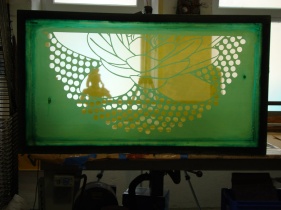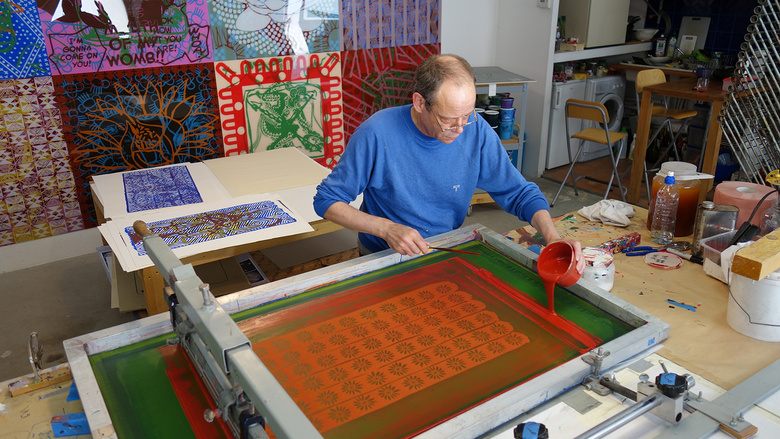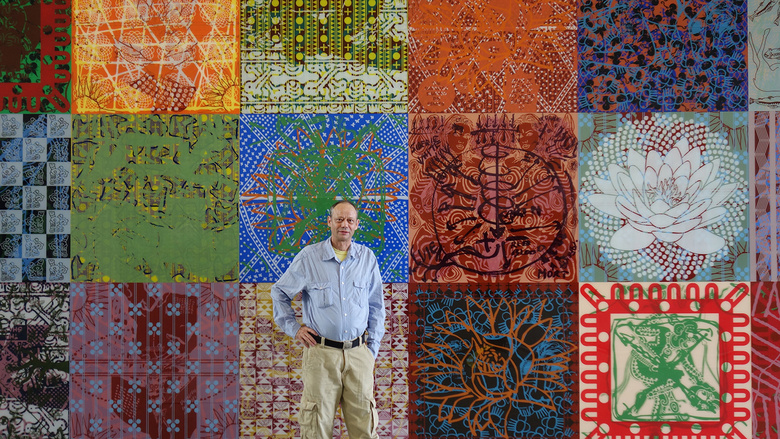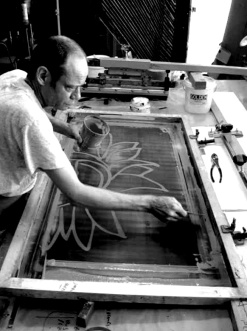Reviews 2018-2020

INTERVIEW WITH CATHERINE JEANSON FOR THE JMH MAGAZINE, SUNDAY JULY 26TH 2020
1/Your works will be included in the exhibition "Voluptés". Couldn't you dream of a better way to enjoy life?
Yes, of course! This exhibition was made possible thanks to my friends Maryse Garinginet and Pierre Bongiovani who were preparing this big summer exhibition "Voluptés" and who came to my studio in December 2019, where Pierre discovered my monumental work. We then decided to present an anthology of erotic works. Eroticism and its pictorial representations being, moreover, the main source of my inspiration. The industrial site of the former Le Chameau factory was the perfect place to hang the large monumental wall installation Mécaniques cosmiques de la jouissance: Eros* & Hildegarde, mystical & sexual ecstasies, 8.40 metres long by 3.15 metres high, as well as the realization of the small cell dedicated to Hildegarde von Bingen, with erotic and mystical works hung inside and outside. As far as the enjoyment of life is concerned, I am not at all epicurean, nor am I an all-purpose, all-purpose, all-purpose person in the Onfrayan sense of the word. Rather, I live very humbly, frugally and simply in my workshop in Besançon, I am vegetarian, travel very little, hardly ever go out, only drink water and green tea.
On the other hand, I think that living is a great happiness and a great joy, following the example of Giono in his book Que ma joie demeure. I am happy with and in nature and with simple and frugal things and would be rather close to the attitude and practices of a Zen or Tibetan Buddhist monk, of those who draw mandalas with coloured sand.
2/The works you will be exhibiting approach sexuality from your own angle. How would you like them to be perceived and understood by visitors who are little or not used to seeing erotic artistic creations in museums or various exhibitions in France?
Understanding eroticism is not easy! And I think that to look at Art, one must eventually become Art, a little like the cicada hunter becoming a cicada at Tchouang-Tseu :
"I hold my inert arm like a withered branch. In the midst of the vastness of the universe and the multiplicity of things, all I know now are cicadas."
This is how you really have to look at Art, like an untamed river, a spring, a wild animal or also a landscape! Shouldn't one look at a work of art with a predefined opinion as to whether it is erotic or not? Because eroticism and sexuality are an integral part of Life and our lives in particular. To dissociate things by prioritizing and classifying them in a rational, scholastic, moral or ethical manner, is to lose all wonder, all emotion and to deprive ourselves of all vitality in the face of life's great adventure and the incessant and fabulous spectacle of Nature!
3/Your creations clearly refer to the enjoyment of women and to women in sexual ecstasy? And man in all this?
We all came out... you and me, from a female body and sex, from a womb and vulva, to put it more bluntly. So the female body is and remains the one in and with which we have lived and are most familiar, and we undoubtedly retain impressions and memories of this intrauterine life.
Moreover, historically, the image of man has only appeared very recently in the iconography of art history. For example, in cave paintings, there are innumerable traces of vulvae, and later many statues of mother goddesses with generous, rounded, gendered forms. There were, of course, some male representations, but mostly ithyphallic, as in the Lascaux Well Scene or in some rock drawings. But it was hardly until the political powers asserted themselves and settled with the arrival of the great Egyptian, Sumerian, Greek or Roman civilizations that there were mostly large colossal statues of powerful and imposing male bodies, such as the Egyptian colossuses of Memnon, Ramses II or the Greek Kouros etc., that the majority of the statues were of men.
For my part, I prefer by far the sensual and spiritual portraits of women such as those of the Egyptian Queen Nefertari, or the Aztec goddess Coatlicue who is overloaded with symbolic elements of life and death: snakes, skulls, hearts etc.. And I wish to remain outside a political system so as not to serve any power, whether male or female, political or religious, and to paint common women or porn stars in a state of sexual pleasure, orgasm and ecstasy.
4/The works you make in silkscreen printing on Plexiglas are at first glance, when they are all put next to each other, very colourful and contain repetitive geometric patterns. Is it to better dress the naked bodies of the women you represent?
Yes and no: it is in fact a bit the technique of veil-unveiled, fishnet stockings and chic lingerie juxtaposed on the erotic parts of ecstatic women's bodies; or are they like nets of primitive fishermen or hunters capturing their prey, thus perhaps creating, somewhere, a staging of desire? But doesn't art exist in any case only through and in a certain staging?
More profoundly than that, all the geometric patterns I use represent for me what can be called matrices of the living. Placentas in which life is created through sexuality. It must be said here that having raised horses for a long time and after the birth of the foal, one must go and throw and bury the deliverance (the placenta in humans) in nature. This symbolic gesture of touching this warm, sticky, blood, smoking and enveloping matter, with its network of blood vessels, has always impressed me. It is de facto The Matrix Network of Life, a creative pattern of joys and dreams, for who hasn't been stunned and subjugated by the furious and astonishing neck of a newborn foal?
5/For you, it is essential not to deprive yourself of all the joys of life. And the body has, for you, a capital importance in the way it is possible to honour life? Do you think that this idea has become obsolete, old-fashioned in today's French society?
I would like to quote this beautiful phrase by Antonin Artaud:
"To break language in order to touch life is to make or remake theatre (Art); and the important thing is not to believe that this act must remain sacred, that is to say reserved. But the important thing is to believe that not everyone can do it, and that it requires preparation." In Le théâtre et son double, P. 19
Again, I'm neither a hedonist nor an epicurean, but stay very sober. On the other hand, one cannot think, love and think without a body and I try, as much as I can, to take care of it and honour it. I don't think this idea is obsolete; on the other hand, I think it's very difficult for me as an artist to live in a totally secularized, deritualized, desanctuarized society. Humanity has always honored Life and Nature in its entirety and diversity. But today, everything is enslaved, diminished, made profitable and even, quite paradoxically, those who, together, have created this modern capitalist slavery. So, of course, our conscious and the collective unconscious are suffering enormously as a result. As well as our poor personal imaginations. Our contemporaries have only mediocre dreams of pre-programmed purchases and adventures: who really wants to go to Disney Land?
We must also have the intellectual honesty to admit that we have now entered a truly post-cultural, global era. So the problem of the disappearance of art or even the body (unless they can both sell themselves, very, very expensive!) as a reflection and fundamental basis of a society or as a best practice for the new generations, unfortunately concerns the whole of humanity and not only our French society!
6/You are very interested in other cultures and you are more particularly fascinated by India, why? You have also travelled a lot and observed populations other than ours? What did you get out of it all?
I was very fortunate to live and work for a very long time in multicultural New York, where I met friends from all over the world, which sharpened and developed my tolerance and curiosity. For example, ways of understanding art and sexuality vary from continent to continent and can be totally different, even opposing, conflicting or antagonistic. These diverse ways of understanding the world and life, through secular and sacred rituals, funeral rites or fertility, have nourished my work since her New York years. Of course, I also love Mexican, Japanese and Indian cuisine.
Some countries interest me particularly because of the power of their philosophy and iconography, such as India for example, a country of spirituality par excellence! I remain really fascinated by their multitude of Goddesses and Gods, often very sexual. One can evoke the Goddess Kali beheading herself during coitus and whose blood spurts from her neck to fill the bowls of these maidservants in order to regenerate the world. For example, here is an excerpt from the 108 Upanishads, the book of Hindu wisdom:
"Thousands of times before - I lived in a mother's womb - I enjoyed a wide variety of foods - And I was breastfed at so many breasts - I was born, and died again - And continually I was reborn again." In Garbha #4
I am also fascinated by all Amerindian cultures and their artistic works, such as the articulated shamanic masks from the West Coast of the United States (the very ones collected by André Breton) or, alternatively, the images of Japanese bondage (kinbaku-bi, magnificent bondage) from which some of my works, being strongly inspired, will also be presented in the exhibition, in particular the large Bondage and Blue Scribble, 2008, 1.50 x 3 meters. We can of course find some of these powerful images in our European Middle Ages or in some "Christian" representations as in Jerome Bosh's depicting Hell and Paradise. But in India, there is no need for Hell or Paradise! Life is shown in this way in its true, raw and sexual reality! And the living energies are in no way weakened or blurred by any moral, humanist or deist thought!
Jean-Pierre Sergent, Besançon, June 24, 2020

ARTICLE IN THE BVV BESANÇON MAGAZINE : SERGENT PAINTER | no 427 DECEMBER 2019-JANUARY 2020
In parallel with the major exhibition La Chine rêvée by François Boucher, the Musée des Beaux-arts et d'Archéologie will house Les quatre piliers du ciel , a monumental installation by the Franco-New York painter Jean-Pierre Sergent. Exactly 72 paintings on Plexiglas, chosen from the series of Entropic Suites and presented on eight panels facing the four corners of the two main staircases. A colourful and bewitching response to a "very sad and grey" contemporary world, these works "speak of my travels and encounters and my immoderate love of colour," the artist confides. In a world that destroys itself, no more time to waste to make art for art's sake, my paintings testify of life itself, no detours, no makeup, no burdens. Life is so!"
Exhibition until October 4, 2020 at MBAA
EXHIBITION AT THE BESANÇON FINE ARTS MUSEUM "The Four Pillars of the Sky" by Jean-Pierre Sergent BY Thomas Comte for La presse Bisontine, December 2019.
The Fine arts Besançon Museum exhibits 72 works by the bisontin artist. A hymn to life and a dialogue with the museum's collections.

By taking the two large stairs of the Musée des beaux-arts et d'archéologie de Besançon, the visitor is welcomed on the first floor by the contemporary works of the French-New York artist Jean-Pierre Sergent, who lives in Besançon, France. 72 of his paintings on Plexiglas in square format have been installed to create an 80 square metre monumental fresco that perfectly covers the corners of each stairwell. To begin with, it is the colour of the whole that fixes the visitor's eye. The impression is confirmed when you arrive at the balcony. From there, it takes time to detail "The Four Pillars of the Sky" to appreciate the unusual reading of the world that the artist presents to the public.
Through the way he portrays the human body in his paintings, drawing symbols from ancient civilizations such as the Mayan one, Jean-Pierre Sergent becomes the messenger of a spirituality whose profound meaning we have lost. "We have lost our vital energy, our connection to the world, what is called "spirituality". However, these peoples had this direct link with the elements. My paintings bear witness to life itself, without detours, without make-up and without burdens," explains Jean-Pierre Sergent, who is happy to exhibit at the Musée des beaux-arts at the request of Nicolas Surlapierre, its director. For the latter, Jean-Pierre Sergent's works have their place. "The museum is not dedicated to contemporary art. However, I like to invite artists whose work is in dialogue with our collections. This makes it possible to look at them in a different way," he explains. His works echo the Egyptian collection and the Amerindian painted skins kept by the establishment.
Looking at "The Four Pillars of the Sky" in detail, we discover erotic scenes, initiatory rites, symbols. The paintings express shamanism, ecstasy, trance. "Many people no longer have pleasure, no desire. We cannot dissociate death, sexuality... all ancient societies as the Hindus understood it. However, our thinking now only works by dissociation," says Jean-Pierre Sergent. In this respect, his silkscreen prints invite us to reflect on who we are.
The poetic pristine primitive art in the works of Jean-Pierre Sergent by Camilla Delpero for Quid Magazine
"I think what makes it a unique work and when it is inhabited by a presence, a soul, that challenges the viewer and takes him to another place." Interview artist Jean-Pierre Sergent.
What is your general poetic?
I always try in my work to acquire a poetic, or poetic coming directly from primitive cultures, free not contaminated by the Structural thoughts, materialistic and monotheists. For example, I love the extraordinary energy from Maya artifacts, Moche, Native Americans, but also by paintings in European or Australian prehistoric caves, because these "poems", these other realities or these energies, lead me in size in which sexuality , death, joy and desire to live and communicate with nature are much more present compared to Western art bringing with it also an essential dimension of cosmic and spiritual!
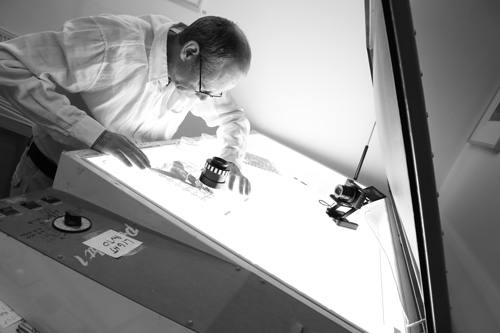
Jean-Pierre Sergent au travail sur les sérigraphiques films, atelier de Besançon, photo Lionel Georges de juin 2019
Explain how a work of art, perhaps a masterpiece, this painting that stands out among the others.
It's not in my nature to try to make a masterpiece, it is opposed to my artistic approach. Jobs in serial and almost ritualistic way: recovery, I choose, rework and create silkscreens popular image or sacred (for certain people and in certain cultures), I add, as in a recipe or in a geographical landscape, overlapping layers of paint up in that they are not satisfied. Without this stratification when something happens at work. It can be an energy, a light, a density, a feeling, a touch. However, the single work is never separated from the whole. They are inscribed in the continuity of my work in dialogue and forming a single work. In particular, my large mural installations of paintings on Plexiglas which are composed of about twenty paintings hung and glued together to form a multiple and Kaleidoscopic work of great dimension.
What is contemporary art for you?
Contemporary art paradoxically creates today a sad constraint and freedom. A freedom, because every artist seems free to create his works in his own way, with his style, with materials that are better suited to his poetry and to be able to talk about subjects that interest him, at least in the West, or in some countries "free" and at peace. On the other hand, the infernal market, consubstantial and functional contemporary art requires hundreds of constraints, countless miseries and deep loneliness for artists who are not able to be part of this world made for a select few happy! Because contemporary art exhibited in museums and exhibitions, depends more and more from this art market controlled and governed by a hundred international gallery owners and collectors who sell l ' Art as a true luxury and consumer product. Unfortunately, many artists are poor and totally unable to enter this system. Today the art could easily appoint post-cultural product and hegemonic. Having no other purpose than to increase the values and exorbitant selling prices of the works! As a result, artists who can not enter the market no longer have any legal existence, human and artistic. This is the price to pay for this globalized capitalist thought, for this uninterrupted spectacle society, where money has become our only reference, our unique value, our only creed and even ... our unique beauty! Today the art could easily appoint post-cultural product and hegemonic. Having no other purpose than to increase the values and exorbitant selling prices of the works! As a result, artists who can not enter the market no longer have any legal existence, human and artistic. This is the price to pay for this globalized capitalist thought, for this uninterrupted spectacle society, where money has become our only reference, our unique value, our only creed and even ... our unique beauty! Today the art could easily appoint post-cultural product and hegemonic. Having no other purpose than to increase the values and exorbitant selling prices of the works! As a result, artists who can not enter the market no longer have any legal existence, human and artistic. This is the price to pay for this globalized capitalist thought, for this uninterrupted spectacle society, where money has become our only reference, our unique value, our only creed and even ... our unique beauty! artists who can not enter the market no longer have any legal existence, human and artistic. This is the price to pay for this globalized capitalist thought, for this uninterrupted spectacle society, where money has become our only reference, our unique value, our only creed and even ... our unique beauty! artists who can not enter the market no longer have any legal existence, human and artistic. This is the price to pay for this globalized capitalist thought, for this uninterrupted spectacle society, where money has become our only reference, our unique value, our only creed and even ... our unique beauty!
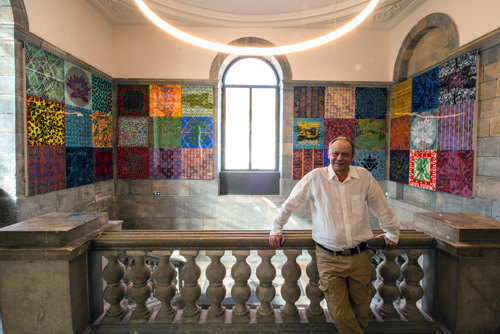
Jean-Pierre Sergent devant l'installation Les quatre piliers du ciel, Musée des beaux-arts de Besançon (80 m2), photo de Lionel Georges, octobre 2019
The magazine is called Quid Magazine because it examines the artistic process. For you, what is the spark that makes it a unique work?
I think what makes it a unique work and when it is inhabited by a presence, a soul that challenges the viewer and takes him to another place that did not reach because of its history and culture. It is the work that intercedes between reality and other worlds most buried, forgotten or betrayed by the thought of the time. You can think of the Demoiselles d'Avignon by Picasso that replenish the world of desire and "primary magic", in an industrializing society, rationalizing that increasingly loses its wonder about the world.
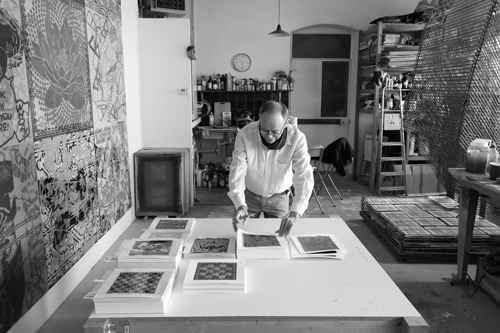
Jean-Pierre Sergent signant les sérigraphies, atelier de Besançon, photo Christine de Chatelet, octobre 2019
What is your teacher?
I'm not really a teacher in the academic sense of the term. During my travels and my many visits to museums, I was particularly touched by some important works and are especially fascinated by all the works (or rather the ritual objects) created by artists, shamans, or intercessors of gods and spirits. Here I would like to copy the list of the works you wish for my imaginary museum, extracted from my interviews filmed with my friend Thierry Savatier, historian: "Yes, probably an erotic and provocative Japanese Shunga, an Egyptian mural, a vase Maya, i think the colors are very beautiful. a statue of the Aztec great energy. a Vermeer, a Giotto, a Rembrandt: the man on the stairs (philosopher in meditation) located at the Louvre, the view of Toledo El Greek, probably one of Matisse paper cut. And I do not know, shamanic masks the west coast of the US, I would say all shamanic masks. I am fascinated by the beauty and grandeur of those works. In addition, the André Breton masks that are of a beauty and amazing intelligence. Some Artaud's drawings, the Yves Klein blues (I forgot Frida Kahlo). Obviously, the drawings of prehistoric caves. "Here, there are not really of the Masters, big or small, but rather a heterogeneous set of works, created by human beings like me, I had the good fortune and great happiness to be able to meet during the my initial many trips all my artistic and spiritual pursuits initiation. shamanic masks the west coast of the US, I would say all shamanic masks. I am fascinated by the beauty and grandeur of those works. In addition, the André Breton masks that are of a beauty and amazing intelligence. Some Artaud's drawings, the Yves Klein blues (I forgot Frida Kahlo). Obviously, the drawings of prehistoric caves. "Here, there are not really of the Masters, big or small, but rather a heterogeneous set of works, created by human beings like me, I had the good fortune and great happiness to be able to meet during the my initial many trips all my artistic and spiritual pursuits initiation. shamanic masks the west coast of the US, I would say all shamanic masks. I am fascinated by the beauty and grandeur of those works. In addition, the André Breton masks that are of a beauty and amazing intelligence. Some Artaud's drawings, the Yves Klein blues (I forgot Frida Kahlo). Obviously, the drawings of prehistoric caves. "Here, there are not really of the Masters, big or small, but rather a heterogeneous set of works, created by human beings like me, I had the good fortune and great happiness to be able to meet during the my initial many trips all my artistic and spiritual pursuits initiation. In addition, the André Breton masks that are of a beauty and amazing intelligence. Some Artaud's drawings, the Yves Klein blues (I forgot Frida Kahlo). Obviously, the drawings of prehistoric caves. "Here, there are not really of the Masters, big or small, but rather a heterogeneous set of works, created by human beings like me, I had the good fortune and great happiness to be able to meet during the my initial many trips all my artistic and spiritual pursuits initiation. In addition, the André Breton masks that are of a beauty and amazing intelligence. Some Artaud's drawings, the Yves Klein blues (I forgot Frida Kahlo). Obviously, the drawings of prehistoric caves. "Here, there are not really of the Masters, big or small, but rather a heterogeneous set of works, created by human beings like me, I had the good fortune and great happiness to be able to meet during the my initial many trips all my artistic and spiritual pursuits initiation.
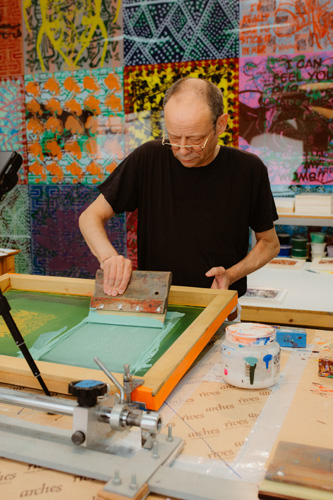
Jean-Pierre Sergent au travail sur les sérigraphies, atelier de Besançon, photo de Sonya Oysel, été 2018
Future projects?
I'll be back from Lugano where I Wopart exhibited at the fair, where we met. I will take part in a Biennale this week in Besançon, where I live now (after having lived and worked for more than 10 years in New York) I have also also a major exhibition at the Museum of Fine Arts which will participate with eight large installations of 3 Wall , 15 x 3.15 m, with a total size of 80 m2.
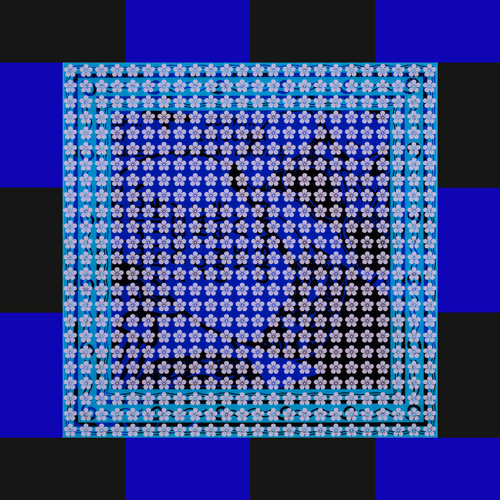
Jean-Pierre Sergent, "entropique Suite # 150", peinture acrylique sur sérigraphiée Plexiglas, 1:40 x 1.40 m, 2015

Interview with Tulika Bahadur for the online magazine On Art And Aesthetic
27 février 2018 | Londres | Royaume-Uni & Australia | download the article
Born in Morteau, France in 1958, French-American artist Jean–Pierre Sergent is known for work that explores the subconscious, fuses the stylistic elements of different civilisations to reveal timeless and universal truths about the human condition, and often recycles seemingly trashy popular imagery into something more epic.
I had a long discussion with him this month—on France, the role of rites and rituals, capitalism and much more. He writes from his studio in Besançon, eastern France.
When I encountered your art, the adjectives that came to my mind were “overarching”, “all-consuming”, also “elemental” and “fundamental”. I identified both a width and a depth in your expression. Width because you incorporate motifs from different cultures—Japanese, Indian, Mayan, Greek—and depth because you are constantly trying to inquire into and reveal the things that matter the most; stuff that stays, endures, gives meaning to existence—desire, beauty, birth, connection, merriment. The texture of your work, I would say, is passionately anthropological. When and how did you develop this fascination with core universal human issues? Does being French have anything to do with it?
Well, it’s always yes and no! Being raised in France was a matter of chance. It is really a rich country, where a lot of different cultures have flourished and merged. We can see it even today with waves of migrants coming from Africa and the Middle East, being stuck and blocked on their way. This has been happening since prehistoric times when the Neanderthal and Cro-Magnon men met and probably interconnected.
The mix of different cultures, a bit like the New York of today, but over a longer period of time, has given me access to a never-ending history of art and thought—the painted caves of Chauvet (35,000 BP), the traditions of the Gallic tribes, the Gothic cathedrals, Picasso, Matisse, Rodin, Voltaire, Sade, Rimbaud, Baudelaire, Claude Lévi-Strauss, Jean Malaurie, etc. At one point, all this French and European culture could be really overwhelming. But to some extent, yes, it opened my mind and gave me a large overview, a global picture.
But I would also say that I have a strong sensitivity and compassion towards other human beings, their living conditions—such as birth, suffering, desire, pleasure, death—and their rituals and gestures—religions, philosophies, architecture, literature, spiritual practices. This interest is something quite common, I share it with most artists.
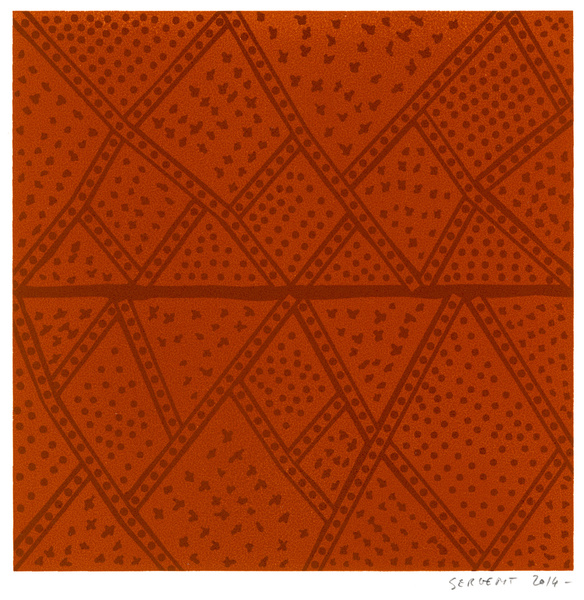
You’ve lived across France, Canada (Montréal) and the US (New York). How have these three locations influenced your vision?
One thing I would like to say about my country, is that, unfortunately, the contemporary art scene here, is totally poor and boring. It’s only intellectual, conceptual, rationalistic, science-driven and spiritless. For me, there is in this art production, a total lack of interest towards human desires. It looks like a flat brain wave, a grey world! This unbearable situation started more or less just after World War II. Art only became “l’art pour l’art”, just an reflection on art history and art processes. Nothing really to enjoy about being alive, it’s at the exact opposite of the so-called “art de vivre français”. I think, this is because French artists born between the two wars, were speechless after all the killings and hecatombs committed during that time.
The “funny thing” is that on the opposite side, our neighbours the German and English artists, from the same time period, have done much better. Think of Joseph Beuys, Anselm Kiefer, Gerhard Richter, Georg Baselitz, or even David Hockney, Francis Bacon! I don’t think that anybody in the world today, could name any living French artist. Am I wrong? They will name Picasso (Spanish born, to whom the French government even denied citizenship) or Matisse, Monet or Gauguin, who died long ago! As some of my American artist friends have said to me: the Frenchies have had their time in art! The only thing that I really enjoy about living in France today is nature.
In Montréal, I found a “new society”, one that was more international, tolerant and respectful of other people’s identities and beliefs. I also loved the immensity of space, sky and place. I started experimenting with different approaches. As for New York, it gave me some of the biggest emotional, artistic, energetic, aesthetic, sexual and human electro-shocks of my life! The Meso-American references in my work are a result of this period. I also got a chance to discover in the museums and through reading, what we call “Primitif Art” or “Art premier” or “Art racine”, from the North American Indian tribes and from all around the world. I discovered Aztec and Mayan artefacts and architecture during some personal trips with my wife Olga (Colombian born) to Mexico and Guatemala. The strong spiritual-magical-cosmical energies that I encountered have converged in my artwork in my large wall installations on Plexiglas titled “Mayan Diary” (1999-2015).

You frequently use repetitive patterns and forms—concentric circles, parallel lines, rows of tiles, sets of triangles. I immediately linked this to rituals—as they are all about doing something again and again and again. So, does the visual component of duplication and recurrence symbolise the nature of rites and ceremonies?

Yes, you are absolutely right! I use patterns as a way of showing a trance-like state and experience. Painting to me is a ritualistic practice. I work with highly symbolic images from pre-industrial cultures that used those designs in order to connect with their gods or spirits; or just for meditation like Indian yantra (with the Bindu point, sort of Big Bang starting point) or Tibetan Mandala to connect with the inner-self and the cosmos. Also to honour some kind of genetical-ancestral connection or create social differentiation (tattoos). Ultimately, to get some primary connection to the essence of life itself. As life keeps repeating through nature, vegetation, animals and mankind. I like my work process to be serial and repetitive with variations of small colours, similar to the Australian Aboriginal Didgeridoo sounds or the Melanesian Polyphonic voice songs.
What strikes me most nowadays is the disappearance of rituals in our developed capitalist countries. With the exception of sports, the only ritual that seems to have survived is marriage. But there aren’t many prayers or dances to help the soul of the dead reaching to the other world (guiding the soul during its long trip, as it has been done since the appearance of mankind), or even to welcome or “baptise” a new born baby. This disappearance is not bad in itself, but it’s not able to reinforce the socials links between people, and as a result, people today are more and more isolated and lonely and are missing all the joy of living and sharing life events together.

In your Culture Trip interview, you say something very important while explaining your work:
First, we have to put things in perspective: the art world and, to an extent, the world as a whole, is no longer a post-industrial, postmodern, or post-religious one, but I think it has become today a post-cultural world. In a few words, all that used to be known by mankind was given and transmitted to us by the cultures we all belonged to and transmitted by the ancestral teachings & traditions. Now all we need to know in order to survive will be used by contemporary computers in the purpose of making money and buying consumer goods, being ‘happy’ without any concern for our surrounding social environment. So the cultural links so important at one time are no more necessary and become just affective ones, that you can choose to use them or not. And of course as people are lazy, they prefer to use the channels of technology instead of the cultural ones, which take much more time to understand and to practise, but which can ground us deeper, with the help of poetry, painting, literature, music, dance, theatre, and spiritual practices, to all human beings, the earth, and the universe.
I have always believed in the value of ancestral teachings and traditions—as long as they are open to scrutiny, criticism and reform. This “post-cultural” situation that you describe indeed troubles me a lot. Cultural links, community ties are now dispensable. What’s more, the human being has been reduced to an audio-visual animal whose primary purpose is to consume goods and services, and whose personal and public data is sold for the strategic promotion of even more goods and services. It’s a vicious cycle.
What, according to you, should/could an artist do in this era of rampant technological invasion?
Being an artist is a lifelong process, it doesn’t come easily, it’s harsh, takes a lot of courage and commitment. In that way, most artists are on the edge of mainstream consumerist beliefs and hurries. It may take more than twenty years of practice, after any art school, to really understand what art as a whole is about.
I think that the mission of an artist, or everybody for that matter, could be related to these words of Henry Miller: “The human mission on Earth is to remember, to remember, to remember.” So an artist could show, name and be the witness of things that are disappearing so fast in front of us. Today, so many cultures, so many spoken languages, so much music, so many love songs, so many animal species, so many forests and rivers have disappeared or been polluted. This has been happening especially since the beginning of the last century, or even from the time of Christopher Columbus. We can name it cultural genocide or earth matricide. Another issue that needs to be brought into attention in art are the freedoms that are denied to women—sexual, aesthetic, intellectual. The mutilations that their bodies suffer in so-called “traditional” societies, the strict dress codes that they must adhere to, the lack of access to good education, etc.

Based on Japanese manga sexual cartoons, Hindu Yantra meditation drawings and genetic patterns from archaic cultures, Entropic Suites (2011-present) is an incredibly rich series. You also mention the Upanishads as inspiration. Tell us more about the impact they have had on you…
It took me over two years to finish reading the 108 Upanishads. It has raised my level of consciousness. Like in Garbha #4:
Thousands of times before / I have lived in a mother’s womb / I took pleasure eating numerous kind of foods / And I have been suckling on so many mother’s breasts / I have been born and been dead again / And endlessly, I came to be born again.
This feeling of being alive so many times and coming back to life so many times and dying so many times and having sexual intercourse so many times, isn’t it something we all have? It reminds me of a quotation by Picasso from André Malraux’s “Le miroir des Limbes”, wherein he relates a meeting with him while talking about the Indian concept of reincarnation. Picasso said: “Do you know what I am thinking sometimes? It’s funny: I am a really superstitious guy. I do have the feeling that it is always the same Little Fellow. Since prehistoric time, he has been coming back, like the wandering Jew. Your fellow Indians, do they believe that painters are reincarnated into painters?” At another part of this interview he said: “That is what needs to be done. We need to paint a painting agelessly. We need to kill contemporary art. In order to create a new one.”

That brings me directly to this other chapter of the Upanishad, which I specially enjoy and respect:
That which is Immensity is felicity, there is no felicity in Exiguity; Immensity alone is felicity; Immensity therefore is worthy of enquiry. That Immensity, O Lord, (said Nārada) is sought by me. (In Chandogya XXXIII)
This is exactly what I am trying to do with my art, getting away from the finite to enter the global and endless world of the infinite, the One. In order to do it, in my Entropic Suites series, I assemble numerous paintings on the wall, with different colour variations, different subject matters and energies. It then allows me to get rid of the simple day to day life experience and enter into a sacred unlimited and infinite space.


At this stage of your career, you are mostly influenced by art from the time when artists were anonymous, as in prehistoric cave paintings, mural paintings from the temples and tombs in ancient Egypt, Mexico or India. What I find interesting here is that art seems like a collective, social enterprise and not “one” pursuit among many that just a “select few members” must engage in. What do you think our contemporary world could learn from the ancient model of creativity?
Yes, one of my major aesthetic shocks happened when I entered, with my granddad Maurice and my sister Marie-Paule, into the tomb of Nefertari, the wife of Ramses II at the Valley of the Queens in Egypt. Of course, it was a collective realisation that was completed by numerous architects, sculptors and painters.
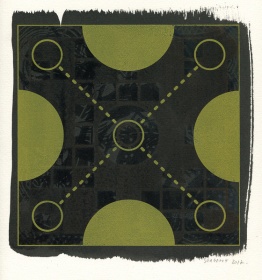
A few reflections on historical and prehistoric artists: some of them were well known for their talents like the Greeks sculptors Praxiteles and Pygmalion. Also Mayan vase painters named themselves its’t (artist-sage). Nevertheless, we can say that the more traditional the society, the less individualistic was the artist. During the Renaissance, the artist and his ego began to be personified, and he started to sign his paintings.
Now art has gone from an artisanal state to an industrial one. It has lost his soul and became just another common trading product. This is certainly due to the secularisation of our contemporaries societies. You can share the experience of the sacred within a social group, but luckily, you cannot share the experience of being a millionaire artist with poor people. Who really cares about a Jeff Koons puppy sold for millions? Absolutely nobody except for a few art aficionados. Not to mention that we are living in a time when most people can’t afford to pay for their rent or food?
But I still think as creators, we can boycott and bypass the system with social networks like Facebook and LinkedIn. We can try, at our own level, to reconnect with the collective mind and subconscious, in order to recreate art that could touch the viewer deep inside, at the core of his soul!

Your work, you write, delves into the subconscious. Are you an avid reader of psychology?
Not really, I am not so interested in reading books about psychology or psychoanalysis! Of course, I have read a few books of Freud (specially Civilisation and Its Discontents and Totem and Taboo) but, as an artist I prefer to read C.G. Jung who had a better understanding of the function of the image and analysed Asian traditions and philosophy pretty deeply. In order to understand unchanging human nature, I like to read a lot of travellers, authors like: Ovid (Metamorphoses), Homer (The Iliad), Ibn Battuta, Marco Polo, James Cook and all the chroniclers of the Spanish conquests like friars Bernardino de Sahagún, Diego Duran and Bartolomé de las Casas.
One of your objectives is to give the viewer an immersive trance-like moment in a world of pleasures and colours, from which conflicts and harshness are not totally absent, but which overall remains without pain and suffering. This wish is a result of your having felt the unpleasantness of asthma as a child. What are your thoughts on the relationship between pain/suffering and creativity/imagination?
Well, to tell you the truth, having suffered from serious asthma attacks at a really young age and having often had the feeling that I was on the edge of dying, forced my brain to find an escape, a way out! I do believe that the brain, with dreams and the capacity of inventing different scenarios, does have a really powerful way of getting us out of terrible situations. It is well known that Marquis de Sade wrote most of his erotic books in the Bastille prison!
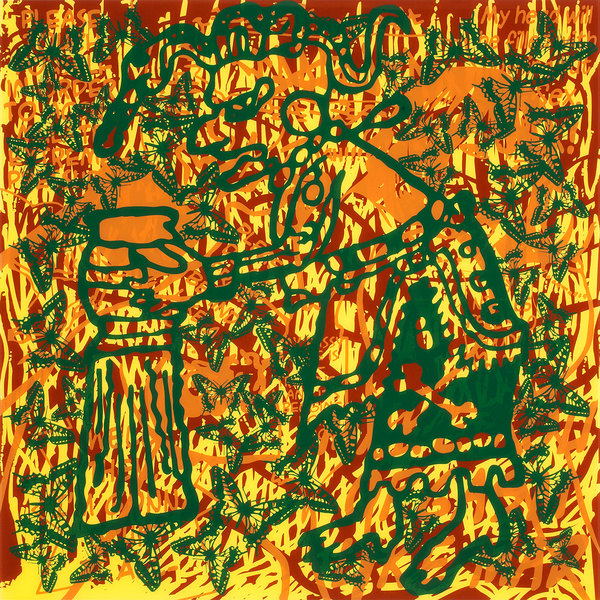
The female form—at times sensuous, at times rather crude—is pervasive in your portfolio, while the male figure remains absent or out of focus. What does the feminine energy/mystique mean to you?
It means everything. We are all born from a woman’s body so I think we are all seeking to return to this prenatal state, the place of which is the womb. Another important thing to say is that the sounds of a female are so powerful that they drive us crazy. Even Ulysses had to be tied up and chained while hearing the languorous songs of the Sirens! My revealing images of women have something to do with a mystical and cosmological connection and experience.
There is a touch of the pop art aesthetic to many of your projects. Are there any pop artists/movements out there that you specifically appreciate?
I got silk-screening from Andy Warhol and Robert Rauschenberg. I am now silkscreening on a printing table on which some of Warhol’s works have been printed. I bought it from my former boss who was a professional silkscreen printer in Long Island City. I also knew the gallery owner Leo Castelli, who discovered and promoted all pop artists.
That said, before coming to New York, I was closer to the paintings of Rothko and Newman and Pollock. But I had seen at the MOMA, the early Targets of Jasper Johns, which made a great impression on me. Firstly, I had the feeling that they were only ordinary objects (like Marcel Duchamp’s Fountain of 1917), but they gave off an aura, a presence (unlike the Fountain), like every classical painting or primitive art. So it was a good surprise for me!
I was also impressed by the Rauschenberg silk-screening technique as he printed almost anything on any material you can think of, and turned it into an art piece. I liked his Rauschenberg Overseas Culture Interchange (ROCI, 1994-1991) project, as he travelled around the world, like a journalist photographing people, in order to make a political statement to defend cultures other than American. I was not so crazy about Lichtenstein’s work, but once I saw his Girl with Ball at the MOMA, it also gave me this feeling of a mysterious presence. Leo Castelli had said in a 70s interview that Lichtenstein came into his gallery to present him his portfolio, with some drawings of comics, and he knew that it was art and not comics. I often think about Castelli as no gallerist nowadays will take the time to see some young artist’s work. That time is definitely gone forever!
So it’s true that I owe a lot to the pop art movement, especially their technique and the use of common images, even though I found their works to be a bit superficial at times!
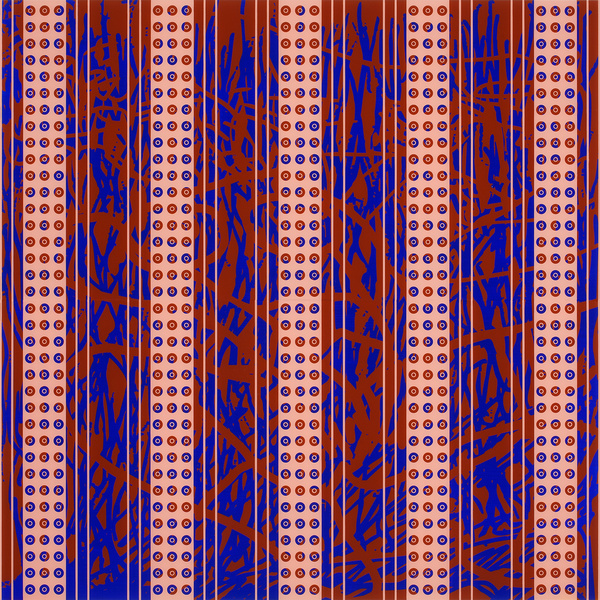
You recently exhibited in Shenzhen, Shanghai and Taiwan. How was the Asian/Eastern experience different from the European/Western one? What is your opinion on the changing landscape of the art market?
I started to exhibit my work in China in 2016, thanks to my friend Xiwen Yang who opened his 50 Plus Contemporary Art Studio in Taiwan. He curated several solo and group exhibitions of my small works on paper, we sold a fews pieces. For now, it’s too early to have a true assessment of the Chinese public’s response, as we haven’t presented any large paintings on Plexiglas installations yet. I really hope that Chinese people will be more open-minded than Europeans who seem really apathetic.
What are you creating right now? And what’s next?
I am finishing the editing of the photos and videos we took during the summertime with my assistant Christine Chatelet, who filmed the working process in the studio. I have also to edit seven new interviews “Palabres dans l’atelier” with my philosopher friend Marie-Madeleine Varet. This spring, when the studio will get warmer, I will continue the printing of my series “Shakti-Yoni: Ecstatic Cosmic Dances”. I have several shows in the works for this year, some group exhibitions with the Keller Gallery, directed by Heidi Suter, in Zurich and the WOPART (works on paper fair) in Lugano, Switzerland. Also a large wall installation in a new Contemporary Art Center in Shenyang, then a solo show in Taipei, Asia. I hope to have a chance to exhibit my work in some new countries, particularly Japan, India or England.
Any concluding thoughts?
I would like to close this interview by evoking joy. A year ago I read Jean Giono’s beautiful book Joy of Man’s Desiring. It is powerful and teaches us, how, even at the worst times, a man who stands up with a strong will, positive thinking and companions could regenerate the dying and worn-out social structures like families, villages, even nature! Consider this extract from another book of Giono’s, Le Chant Du Monde:
Antonio thought about that path open in the Sky through which something was coming and touched the Earth. He heard deep inside of himself some desires, some wind, and some noises from the River.
Find Jean-Pierre on his website (www.j-psergent.com), Facebook (www.facebook.com/jpsergentartist) and LinkedIn profiles (www.linkedin.com/in/jsergent).
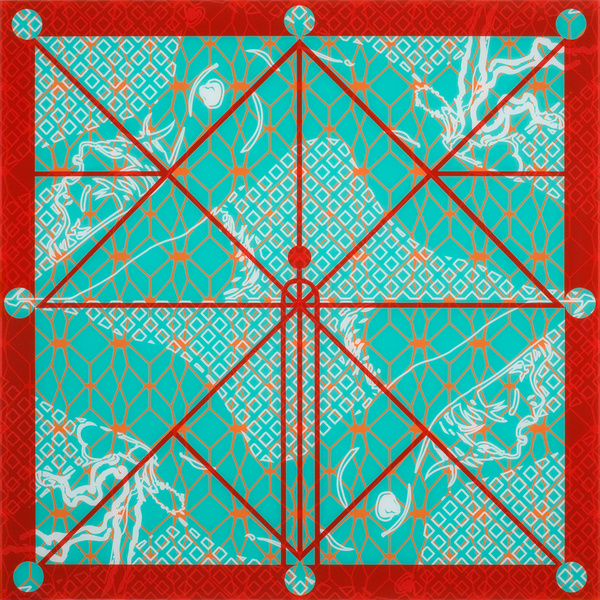


El taller de Jean Pierre Sergent: bringing to ligth…
Las imágenes del taller de Jean Pierre Sergent muestran el proceso creativo de impresión del acrílico mediante la técnica del stencil y el shablon.
The images from Jean Pierre Sergent’s workshop show the creative process of acrylic printing through the technique of stencil and shablon.

Cada momento de la creación en sus obras es singular,dando lugar a nuevos fragmentos.Múltiples textos que están contenidos en una obra que es un palimpsesto.
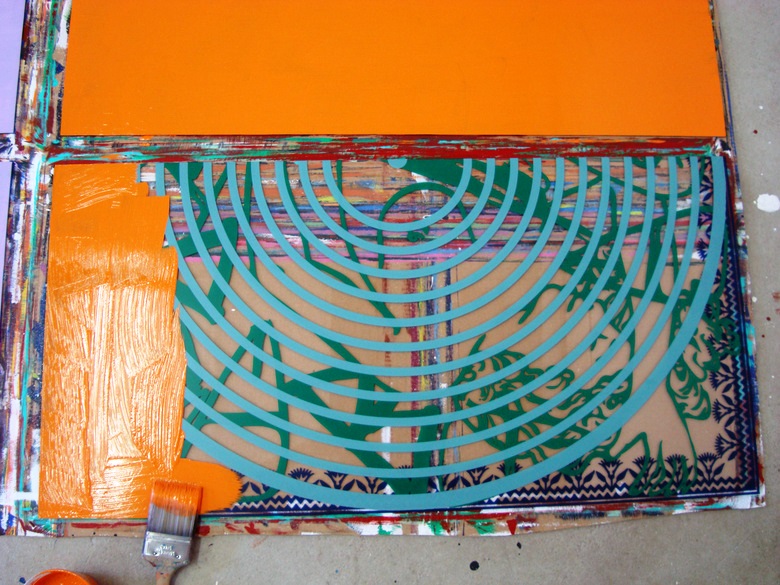
Each moment of creation in his work is unique,bringing to ligth new fragments.Multiple texts contained in a work that is like a palimpsest.
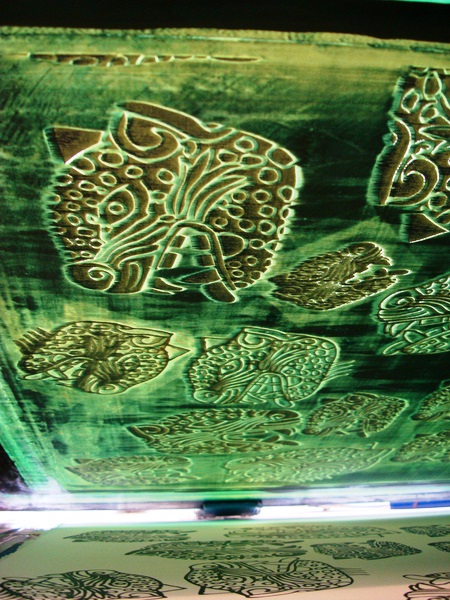
Como un texto re escrito a lo largo del tiempoLas obras de Jean Pierre Sergent reúnen estilos, técnicas,jugando con la historia del arte y sus períodos.Las obras dentro de la obra se trasponen creando una polifonía de mágicas figuras.
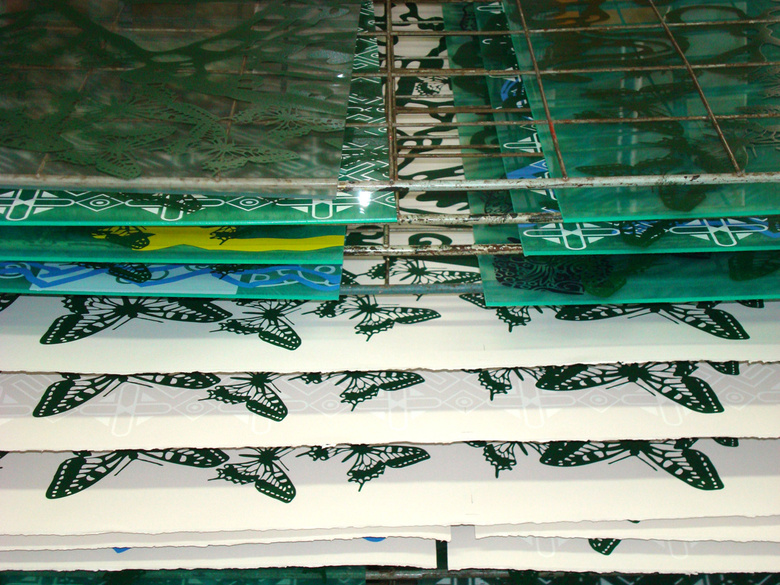
As a text rewritten over time,the works of Jean Pierre Sergent bring together styles, techniques,playing with the history of art and its periods.The works within the artwork are transposed creating a polyphony of magical figures.
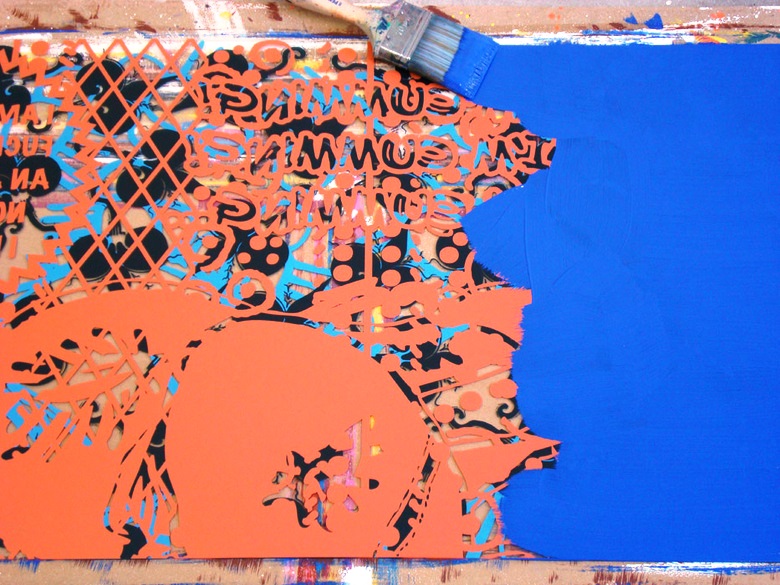

Jean-Pierre Sergent: creando la vida/ creating life
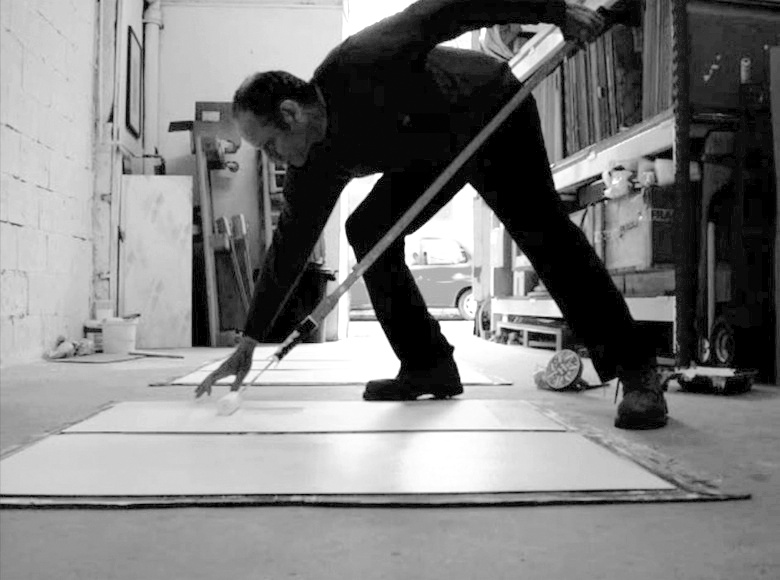
En el taller de Jean-Pierre Sergent, el trabajo es en sí mismo una forma de arte.El es el protagonista de una imagen-cuadro viviente,una obra que es un relato acerca de otras obras. Miles de símbolos toman forma, y son reproducidos, formando tramas, ventanas, superponiéndose.El esfuerzo físico va concretando imágenes que brillan, proyectando luz translúcida y opaca.Jean-Pierre nos muestra su visión del Arte como un elemento que se reimprime y toma por sorpresa al artista, cambiando su vida, haciéndolo producir, generando un cambio en su entorno y en su propia personalidad.La creación como forma de vida, o la vida como una creación al que damos forma todos los días, re-produciéndonos hasta lograr la mejor versión de nosotros mismos.
At Jean-Pierre Sergent’s workshop, work it´s an art form for itself.He is protagonist of a living picture- or living artwork. A work that is a story about other works. Thousands of symbols take shape, being reproduced, creating weaves , windows and different layers. Physical effort concretes images that shine, projecting translucent and opaque light. Jean-Pierre shows us his vision of Art as a reprinting that takes the artist by surprise, changing his life, making him produce, generating a change in the environment and in his own personality. Creation as a way of life, or life as a creation that we give shape every day, re-producing until we discover the best version of ourselves.
El taller de Jean- Pierre Sergent/ Jean Pierre Sergent Workshop
Obras que se revelan a cada paso de un proceso mágico de impresión y estampado en acrílico.Capas de color que dan vida a diferentes mandalas.Ventanas que difuminan la luz y nos permiten ver el interior del taller de Jean- Pierre Sergent.